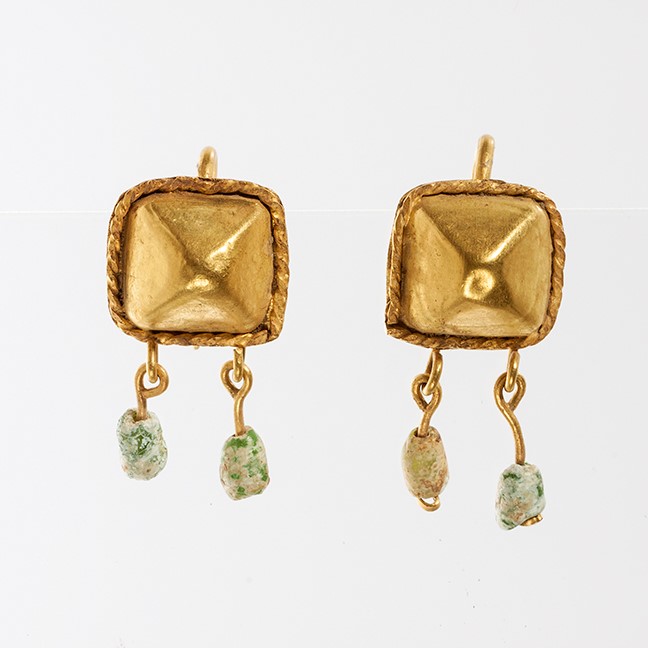
Collections:
Description:
Jewellery
Introduction by J.R. Green
The habit of adorning one’s body and clothes with ornament is fundamental to human social life, and in the classical world there was a steadily-developing sophistication in the techniques of jewellery and the employment of precious materials and stones. Expenditure on jewellery can also be regarded as an indicator of a society’s available wealth. In the Mycenaean period jewellery was largely limited to the upper classes, and the collapse of the palace culture at the end of the Bronze Age is reflected in the marked decrease in finds of elaborate jewellery, especially imported gold and ivory. The bronze spectacle-fibula, 1980.12, is a good example of a style and type of jewellery found in the emerging Greek culture of the period of Homer. In the Archaic and Classical periods, gold still remained fairly rare, though access to gold mines in the area north of the Aegean and around the Black Sea became steadily easier and more frequent. A huge change came about with the conquests of Alexander the Great which brought access to a much wider range of sources as well as a considerable amount of booty from the conquered peoples, not least those of Persia and Egypt. For objects of this period, see 1965.01, 1986.01 and 1971.11.
There is also a good amount of Roman jewellery surviving. Our ANU collection once included a Roman flexible gold chain (1986.12), a Roman gold ring with portrait stone (1972.05) and a pair of Roman gold earrings (1978.07). (See attached images). These three items were stolen from the collection on 9 December 2004. Also interesting, apart from the gilt dress pins, is the brooch, 1977.04, which includes enamel. It is of a kind that has Celtic associations and is found particularly in the area of Germany. There is also a necklace of glass beads that seem to imitate amber.
Most of this material will have been found in graves.
There are several useful introductory studies of ancient jewellery, although most of them concentrate on gold. One may note particularly R. Higgins, Greek and Roman Jewellery (2nd ed., London 1980); J. Ogden, Jewellery of the Ancient World (London 1982), and Ancient Jewellery (London 1992). The latter are particularly good on matters of technique and make reference to more specialised studies. There is a useful and comprehensive study from P.G. Guzzo, Oreficierie dalla Magna Grecia. Ornamenti in oro e argento dall’Italia Meridionale tra l’VIII ed il I secolo (Taranto 1993) and the attractive volumes by A. Despini, Greek Art: Ancient Gold Jewellery (second ed., Athens 2006) and M. Jackson, Hellenistic Gold Jewellery in the Benaki Museum, Athens (Athens 2017).
For a useful study of ancient references to jewellery and the terminology used for the various items, see S. Russo, I gioielli nei papiri di età greco-romana (Florence 1999).
Gold
In addition to the items mentioned at the head of this section, one may also note H. Hoffmann and V. von Claer, Antiker Gold- und Silberschmuck (Mainz 1968); B. Deppert-Lippitz, Griechische Goldschmuck (Mainz 1985); D. Williams, The Art of the Greek Goldsmith (London 1999).
There have also been some important exhibition catalogues: H. Hoffmann and P.F. Davidson, Greek Gold Jewelry from the Age of Alexander (Brooklyn NY 1965); E.M. De Juliis et al., Gli ori di Taranto in età ellenistica (Exhib.Cat., Milan 1984); D. Williams and J. Ogden, Greek Gold: Jewellery of the Classical World (London 1994); ΤοΕλληνικόΚόσμημα. 6,000 Χρόνια Παράδοση(Exhib. Cat. Thessalonike 1997-1998, Athens 1997).
Among more particular studies and groups of material: T. Hackens and R. Winkes, Gold Jewelry. Craft, Style and Meaning from Mycenae to Constantinopolis (Louvain-la-Neuve1983); B. Deppert-Lippitz, “Römischer Goldschmuck - Stand der Forschung”, in: H. Temporini (ed.), Aufstieg und Niedergang der Römischen Welt II.12, 3 (1985) 117-126; F. Baratte, Le trésor d'orfèvrerie romaine de Boscoreale (Paris 1986); D. Williams, “Three Groups of Fourth Century South Italian Jewellery in the British Museum”, Mitteilungen des Deutschen Archäologischen Instituts, Römische Abteilung 95, 1988, 75-95; Chr. Eluère (ed.), Outils et ateliers d'orfèvres des temps anciens (Colloque int. 1991, Saint-Germain-en-Laye 1993).